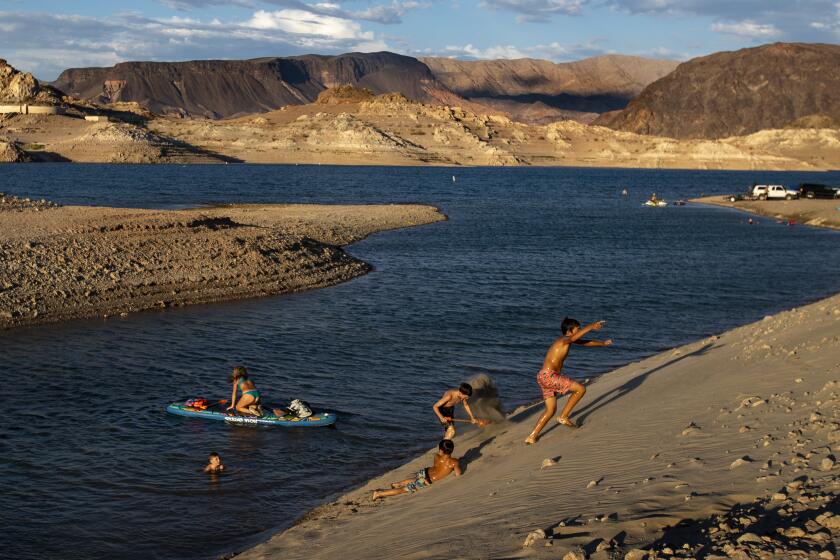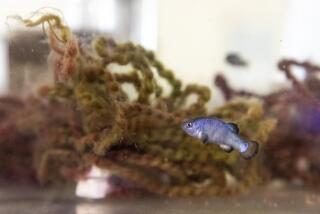
It was 111 degrees when Mark McBroom stepped from his air-conditioned pickup and onto a dry alfalfa field. Remnants of desiccated hay crunched underfoot, and the sun-baked soil was fragmented with deep cracks.
McBroom and other Imperial Valley farmers agreed to leave many hay fields unwatered for seven weeks this year in exchange for cash payments from a federally funded program designed to alleviate the water shortage on the Colorado River.
Many farmers decided that the payments — $300 per acre-foot of water conserved — would pencil out for them this year, in part because hay prices have recently fallen.
“Most of the farming community felt like our water is worth a lot more than that, but we wanted to help,” McBroom said. “We want to be good neighbors.”
Aggressive and impactful reporting on climate change, the environment, health and science.
But while the three-year deal is helping to save water in the river’s reservoirs, some people in the Imperial Valley say they’re concerned it’s also accelerating the decline of the Salton Sea and worsening environmental problems along its retreating shores.
With less water running off fields and into the sea, growing stretches of dry lakebed are being exposed to desert winds that kick up lung-damaging dust. At the same time, the lake is growing saltier as it shrinks, bringing changes to a habitat that is a vital stopover for migratory birds.
“This three-year deal is accelerating the receding of the sea,” said Eric Montoya Reyes, executive director of the nonprofit group Los Amigos de la Comunidad. “It’s going to impact our community.”

The voluntary water-saving program is an unusual effort by farmers who receive the single largest share of Colorado River water. While the growers adamantly oppose leaving farmland permanently dry, they decided that shutting off water temporarily to hay fields would help conserve supplies and minimize effects on crop production and the local economy.
Leaders of the Imperial Irrigation District say their agreement with the U.S. Bureau of Reclamation will save up to 700,000 acre-feet of water — enough to raise the level of Lake Mead, the country’s largest reservoir, more than 10 feet.
But environmental advocates have argued that the irrigation district’s deal with the federal government fails to adequately address the effects on the shrinking lake.
The Salton Sea, California’s largest lake, has long been fed by agricultural runoff. The lake has been drying up over the last two decades as a result of a 2003 deal in which the Imperial Irrigation District, or IID, transferred a portion of the valley’s water to growing urban areas.

For years, local activists and residents in the Imperial and Coachella valleys have urged state officials to speed up long-delayed efforts to build wetlands along the retreating shores to create wildlife habitat and control dust that contributes to high asthma rates.
Reyes has criticized IID officials for doing “backroom deals” and “leaving the community out.”
Leaders of several other groups, including Alianza Coachella Valley and Audubon California, said the water cuts under the new program come on top of lower-than-expected water use in the region this year, and have led to what they say is an alarming acceleration of the lake’s decline. They say that since the conservation program began in mid-August, the Salton Sea’s surface has fallen about 10 inches and the lake has shrunk by about 3,500 acres, exposing new stretches of dust-emitting playa.
“There are impacts right now, and those should be recognized,” said Michael Cohen, a senior researcher at the Oakland-based Pacific Institute. He said he hopes the state and the IID will accelerate the work of building wetlands to protect threatened birds and fish species, and to ensure that additional dust doesn’t worsen air quality in nearby communities.

The Sierra Club has filed a lawsuit challenging the district’s approval of the conservation program, saying it violated state law and will mean additional environmental impacts that hadn’t been contemplated. Joan Taylor, the group’s California conservation chair, said the Sierra Club recognizes the need for saving water but that the environmental effects shouldn’t be ignored.
She said the IID “has a responsibility to mitigate those additional impacts.”
New research examines how much global warming has sapped the Colorado River since 2000. It shows the region has lost more water than Lake Mead can hold.
Despite the legal challenge, IID officials said they complied with the law when they carried out an environmental assessment and launched the conservation effort, which they call a deficit-irrigation program.
The district said in a written statement that it “remains dedicated to ensuring the long-term sustainability of the Colorado River while also addressing the immediate needs of the Salton Sea and surrounding communities.”
“Our goal is to protect both our region’s water supply and the health of residents and wildlife, and we will continue to take proactive steps in maintaining that balance,” the district said.

State officials are years behind schedule on plans for building wetlands at the Salton Sea, but as of this month the state has largely finished construction of a 4,100-acre habitat area along the south shore. In other areas, thousands of hay bales have been placed in rows on the lakebed to help control dust.
Gov. Gavin Newsom signed legislation this year establishing a Salton Sea Conservancy that will coordinate efforts to protect public health and bolster the lake’s ecosystem.
The Biden administration has pledged $250 million from the Inflation Reduction Act to help expand the Salton Sea projects. Tina Shields, the IID’s water manager, said the district’s leaders hope the lawsuit doesn’t delay the transfer of $170 million to the state this year.
“That causes us a little bit of concern that that could be interrupted, which would halt the projects out there at this point,” Shields said. “We understand there are concerns and issues, but at the end of the day, the Salton Sea has no water if Imperial Valley has no water, so we’re going to do our best to protect the river for the community and the growers — and the region as a whole.”

The Colorado River provides water to seven states from Wyoming to Southern California, as well as 30 tribal nations and northern Mexico. The river has long been overallocated, and reservoir levels have dropped as hotter, drier conditions have reduced flows over the last 25 years.
Scientists have found that global warming has contributed significantly to the decline in the river’s flow since 2000.
The river’s condition has improved somewhat with wetter winters since 2023. But Lake Mead remains just 33% full, while the second-largest reservoir, Lake Powell, is now at 39% of capacity.
The Biden administration’s three-year agreement with the IID is the largest in a series of conservation deals supported with federal funds. Federal Reclamation Commissioner Camille Calimlim Touton said these drought agreements are key to the stability of the water supply for millions of people and agriculture in the Southwest.
The federal government will provide $589 million to support conservation in the Imperial Valley through 2026, with funds going to the district as well as farmers who enroll in the programs.
The deficit-irrigation program began Aug. 13. Crews shut canal gates with locks and zip ties, cutting off water to about 1,800 hay fields.

Left dry were fields of alfalfa, Bermuda grass and klein grass — in all more than 154,000 acres, or roughly a third of the valley’s irrigated land — forming a stark patchwork of brown fields interspersed with lush green crops.
Since the program ended Sept. 30, canal gates have been reopened and farmers have begun nursing fields back into production.

“It’s working as expected to date,” McBroom said as he inspected his dry fields in late September.
He said after workers “scratch up” the ground and reseed the field, alfalfa should grow back and thrive. An alfalfa field typically keeps producing for four years or more, and growers often harvest eight or nine cuttings of the cattle-feed crop per year.
“It’s a hardy plant,” McBroom said. “These fields are some really strong ground, and so this should come back really well.”
McBroom and other growers say they don’t expect the water-saving program to have a significant effect on the Salton Sea beyond the reductions in water use that were already occurring before the deal. They also point out that as agriculture becomes more water-efficient, the inflows that feed the lake will naturally continue to diminish.
McBroom, who also grows lemons, dates and other crops, enrolled most of his hay fields in the conservation program. He said he hopes other communities follow the Imperial Valley’s example by stepping up efforts to reduce water use.
However, he said he hopes the approach of idling farmland will be temporary and end after three years.
“I don’t think that the farming community really wants to see much more of our resource leave,” he said.
Colorado River in Crisis is a series of stories, videos and podcasts in which Los Angeles Times journalists travel throughout the river’s watershed, from the headwaters in the Rocky Mountains to the river’s dry delta in Mexico.
Other farmers agree. Brett Miller said the current program is “a strong solution in conserving a lot of water, and doing so without crippling our local farming industry, as full-year fallowing has done elsewhere.”
“We still need to see if the program impacts our yields in the following months. We can use this time to apply fertilizer or compost and hopefully have strong plant stands when we irrigate again,” Miller said.
Ed Hale, who shut off water to most of his alfalfa fields, said the approach of leaving fields dry on a voluntary basis for a short period limits the economic harm.
“Nobody wants to see long-term fallowing,” Hale said. “It’s a community killer.”
Farmers say they would prefer to expand another existing conservation program that pays those who invest in improving water efficiency on their fields.
“I’m a big believer in true efficiency-based conservation,” said Scott Emanuelli, a fourth-generation farmer and president of the Imperial County Farm Bureau.

He said investing in more efficient irrigation systems and other water-saving improvements requires substantial investments and time, but would allow the valley to conserve more without leaving farmland dry and fallow.
“I don’t want to stop farming as my method of conservation,” he said. “We want to continue to farm, and do our part where we can.”









